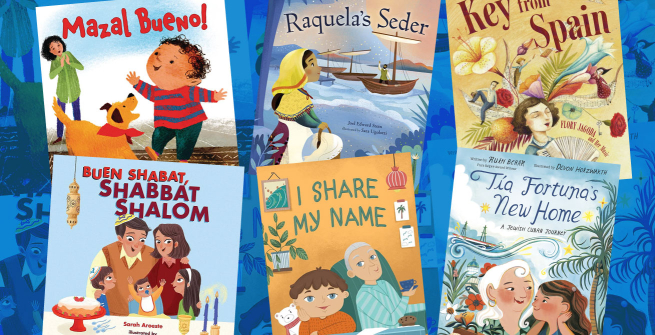Last week, I came across a perfect Mother’s Day gift in the form of Mazal Bueno! a new board book by Sarah Aroeste sprinkled with Ladino, the Judeo-Spanish language of Sephardic Jews. My mom, known as Nona to her six grandchildren, will no doubt light up at this simple tribute to families like ours who may no longer fluently speak the dialect derived from Old Spanish but still find ways to weave it into the texture of our lives.
Like Mazal Bueno!, which uses the titular exclamation to celebrate baby taking a first step or starting solids, Ladino shows up in our family in small but meaningful ways: As a term of endearment (fijo bueno or fija buena means good boy or good girl) or during the holidays like Passover when we read from Haggadahs with text in Hebrew and Ladino. Even using the name Nona for grandmother is keeping with the Sephardic tradition.
Ladino is a reminder of our history, tracing back to 1492 when Jews were expelled from Spain and scattered into the diaspora, but it’s not a relic. My own Nona and Nono spoke Ladino as well as Greek, the language of their ancestors’ adopted home, their entire lives. After they immigrated to Los Angeles as refugees following World War II, they started a family, found a Sephardic Greek community, and passed on both languages to their two children. Over time, for my mother, who went on to minor in Spanish as an undergraduate and eventually became an elementary school teacher here in L.A., Ladino faded into contemporary Spanish. This is a very common story. Today, there are so few Ladino speakers that it’s considered an UNESCO endangered language and there are academic efforts toward preservation. And yet, in Sephardic culture, carried on through food, music, and the books we share with the next generation, we maintain the connection.
But it does take work. Even among books that center Jewish families and traditions, while there is more variety in representation than years past, it’s still more common to see Ashkenazi Jews with an Eastern European background, peppering their language with Yiddish (the Germanic counterpart to Ladino) words and phrases like bagel, Bubbie, and oy vey.
The same is true of children’s non-fiction. It’s rare to see biographies of notable Jewish figures or discussions of Jewish holidays that reflect diversity in heritage, race, or ethnicity, so a couple of years back I perked up at The Key from Spain: Flory Jagoda and Her Music. The picture book biography shines a light on the origins and legacy of Ladino through the extraordinary personal story of Flory Jagoda, a Bosnian-born Holocaust survivor. After immigrating to the United States, the singer, and composer became a champion of Ladino music, performing songs like her best-known Hanukkah hit, "Ocho Kandelikas," (available on Freegal!) across the world.
I know that I’m not alone in treasuring these discoveries, that reflect and reveal different kinds of Jewish experiences, so in celebration of Jewish American Heritage Month, here is a list of picture books with Sephardic representation from our (still growing) collection.







